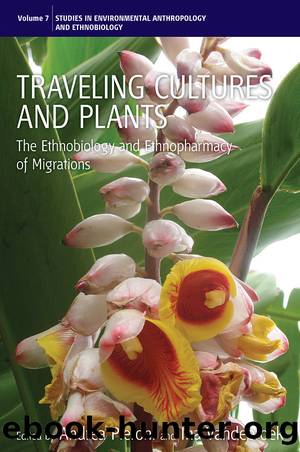Traveling Cultures and Plants by Vandebroek Ina. Pieroni Andrea

Author:Vandebroek, Ina.,Pieroni, Andrea.
Language: eng
Format: epub
Publisher: Berghahn Books
Chapter 7
The Use of Home Remedies
for Health Care and Well-Being
by Spanish-Speaking Latino
Immigrants in London
A Reflection on Acculturation
Melissa Ceuterick, Ina Vandebroek,
Bren Torry, Andrea Pieroni
Introduction
Today Britain is one of the most multicultural of societies, encompassing traditional Commonwealth immigrant groups from Indian, Caribbean, African, and Irish descent, as well as increasing numbers of people originating from South America and Central Europe (Kyambi 2005). Despite the governmentâs aim of rendering the National Health Service (NHS) more culturally appropriate for the ethnically diverse population, little attention has been paid to study traditional health care practices of immigrant communities in the United Kingdom (UK) (Green et al. 2006). When people migrate to urbanized centers, they often bring along their medical traditions. Balick et al. (2000) describe how immigrant communities in New York City continue to import, buy, and utilize traditional remedies. Urban ethnobotany studies these plants used as medicine by ethnic communities in an urban environment, and also focuses on the changes that traditional medicine undergoes when it is transplanted from one culture to another. The present study aspires to contribute to this new discipline, by exploring the plants that are used for health care by Latino immigrants in London, and the influence of migration on these medical practices. Doing so, the study also aims to provide a better insight into particular health care patterns of one of Britainâs least documented communities, the Latino population. The results that are presented are based on nine months of fieldwork among the Spanish-speaking Latin American community in London (September 2005âMay 2006).
This chapter starts with a general outline of the community in London and will then focus on the subject of the illness narratives of Latinos and their choice of plants for health care. Medical anthropological theories on the concepts of âillness and diseaseâ will clarify the issue of the incorporation of both English terms into one word in Spanish (enfermedad), and its particular difference with the commonly used concept of discomfort (malestar). Theories on medicalization will allow exploring this linguistic discrepancy more profoundly. In addition, Kleinmanâs (1980) model on health care systems, and the updated version of Stevenson et al. (2003) will be put forward as a framework for Latinosâ choice of health care. This theoretical explanation will provide the fundaments for discussing the different types of natural home remedies used by Latinos in London. It will be shown that, in general, people use plants for self-treatment of minor ailments and for maintaining well-being in a home context. Yet, the medicinal plants reported by the participants represent only a part of what they used formerly. Furthermore, there appears to be a substantial difference between passive and active knowledge, i.e., between past uses and maintained practices. Hence, it will also be explored what the main reasons for this difference are, and if these can be ascribed to acculturation processes. It will be hypothesized that the use of herbal remedies by Latinos is mainly influenced, and even dominated, by practical, material factors, such as import regulations, and is not always a matter of âfree choice.
Download
This site does not store any files on its server. We only index and link to content provided by other sites. Please contact the content providers to delete copyright contents if any and email us, we'll remove relevant links or contents immediately.
Japan Eats! by Betty Reynolds(823)
Mr. Selden's Map of China by Timothy Brook(775)
The Hunt for Mount Everest by Craig Storti(757)
Philippines--Culture Smart! by Culture Smart!(669)
The Meaning of India by Raja Rao(631)
Food of India by unknow(618)
India--Culture Smart! by Becky Stephen(603)
Rick Steves Germany by Rick Steves(593)
Cross Winds: Adventure and Entrepreneurship in the Russian Far East by Myers Steven(592)
North of South by Shiva Naipaul(591)
Ethiopia--Culture Smart! by Culture Smart!(576)
Lonely Planet's Ultimate Travel by Lonely Planet(555)
Bangkok Noir by Christopher G. Moore(542)
The Amur River by Colin Thubron(541)
Ghana--Culture Smart! by Culture Smart!(514)
Istanbul by Bettany Hughes(509)
Sake and the wines of Japan by Anthony Rose(508)
Florida by Lonely Planet(496)
Hill Railways of the Indian Subcontinent by Richard Wallace(486)
